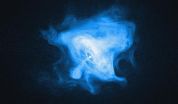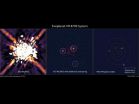(Press-News.org) AMES, Iowa -- Iowa State University astrophysicists are part of an international team that unexpectedly discovered very-high-energy gamma rays from the already well-known Crab pulsar star.
The team's findings are published in the Oct. 7 issue of the journal Science.
"This is the first time very-high-energy gamma rays have been detected from a pulsar - a rapidly spinning neutron star about the size of the city of Ames but with a mass greater than that of the sun," said Frank Krennrich, an Iowa State professor of physics and astronomy and a co-author of the paper.
The discovery was the work of three post-doctoral researchers – including Martin Schroedter, who left Iowa State last year for a position at the Fred Lawrence Whipple Observatory near Amado, Ariz.
The researchers' finding was a surprise, said Amanda Weinstein, an Iowa State assistant professor of physics and astronomy. Astrophysicists started looking for very-high-energy gamma rays from the Crab pulsar decades ago and had never found them with energies greater than 25 billion electron volts.
This time, using the $20 million Very Energetic Radiation Imaging Telescope Array System (VERITAS) in southern Arizona, the researchers discovered pulsed gamma rays from the Crab pulsar that exceeded energies of 100 billion electron volts.
Krennrich said such high energies can't be explained by the current understanding of pulsars.
Pulsars are compact neutron stars that spin rapidly and have a very strong magnetic field, Krennrich said. The spin and magnetism pull electrons from the star and accelerate them along magnetic field lines, creating narrow bands of "curvature radiation."
Krennrich and Weinstein said curvature radiation doesn't explain the very-high-energy gamma rays reported in the Science paper. And so astrophysicists need to develop new ideas about pulsars and how they create gamma rays.
Gamma rays are a form of high-energy electromagnetic radiation. They have energies of one million to several trillion electron volts; the energy of visible light is one electron volt.
Even with their very high energies, gamma rays can't penetrate the earth's atmosphere. When they hit the atmosphere, they create showers of electrons and positrons that create a blue light known as Cerenkov radiation. Those showers move very fast. And they're not very bright.
And so it takes a very sensitive instrument such as VERITAS to detect those rays. VERITAS features four, 12-meter reflector dishes covered with 350 mirrors. All those mirrors direct light into cameras mounted in front of each dish. Each camera is about 7 feet across and contains 499 tube-shaped photon detectors or pixels.
All those detectors were built in a laboratory on the fourth floor of Iowa State's Zaffarano Physics Addition. The assembly took about $1 million and a lot of work by a team of Iowa State researchers.
Weinstein, then working as a post-doctoral researcher at the University of California, Los Angeles, helped design and build the VERITAS array trigger. The trigger is an electronics system that works in real-time to determine which telescope observations contain useful data that should be recorded for analysis.
Researchers believe a better understanding of gamma rays could help them explore distant regions of space, help them look for evidence of dark matter, determine how much electromagnetic radiation the universe has produced, answer questions about the formation of stars and help explain the origins of the most energetic radiation in the universe.
The three lead authors of the Science paper are Schroedter; Andrew McCann of McGill University in Montreal; and Nepomuk Otte of the University of California, Santa Cruz and now at the Georgia Institute of Technology in Atlanta. Iowa State co-authors are Krennrich; Weinstein; Matthew Orr, a post-doctoral research associate in physics and astronomy; Arun Madhavan, a doctoral student in physics and astronomy; and Asif Imran, a former Iowa State doctoral student who's now at Los Alamos National Laboratory in New Mexico.
The research project was supported by the U.S. Department of Energy Office of Science, the National Science Foundation, the Smithsonian Institution, the National Sciences and Energy Research Council of Canada, Science Foundation Ireland, and the Science and Technology Facilities Council in the United Kingdom.
There's more than a gamma-ray discovery in this particular research paper, Weinstein said. There's also a lesson about scientific discovery.
"Because this was something people didn't expect, it took courage to pursue this study," she said. "The lesson is you keep making your instruments better and you keep looking."
INFORMATION:
Contacts:
Frank Krennrich
Physics and Astronomy
515-294-3736
krennich@iastate.edu
Amanda Weinstein
Physics and Astronomy
515-294-6448
amandajw@iastate.edu
Mike Krapfl
News Service
515-294-4917
mkrapfl@iastate.edu
Iowa State researchers help detect very-high-energy gamma rays from Crab pulsar
2011-10-10
ELSE PRESS RELEASES FROM THIS DATE:
Lottery Player Wins 65 Million Euro SuperEnalotto Jackpot
2011-10-10
After several months waiting for a top prize win, the massive SuperEnalotto jackpot was finally won by an anonymous player from the Italian town of Gubbio. This being said, let's discuss the multi-million Euro jackpot, along with the winning numbers from last week's SuperEnalotto drawings:
The winning lottery numbers were 4, 6, 27, 37, 45, and 58. The "jolly" bonus number was 84.
SuperEnalotto lottery draws take place in Rome, Italy, on Tuesday, Thursday and Saturday evenings. The odd of winning the SuperEnalotto jackpot is 1:622,614,630.
The previous ...
Archaeologist argues world's oldest temples were not temples at all
2011-10-10
Ancient structures uncovered in Turkey and thought to be the world's oldest temples may not have been strictly religious buildings after all, according to an article in the October issue of Current Anthropology. Archaeologist Ted Banning of the University of Toronto argues that the buildings found at Göbekli Tepe may have been houses for people, not the gods.
The buildings at Göbekli, a hilltop just outside of the Turkish city of Urfa, were found in 1995 by Klaus Schmidt of the German Archaeological Institute and colleagues from the Şanlıurfa Museum in Turkey. ...
Ionic liquid catalyst helps turn emissions into fuel
2011-10-10
CHAMPAIGN, Ill. -- An Illinois research team has succeeded in overcoming one major obstacle to a promising technology that simultaneously reduces atmospheric carbon dioxide and produces fuel.
University of Illinois chemical and biomolecular engineering professor Paul Kenis and his research group joined forces with researchers at Dioxide Materials, a startup company, to produce a catalyst that improves artificial photosynthesis. The company, in the university Research Park, was founded by retired chemical engineering professor Richard Masel. The team reported their results ...
Somoto Releases its 2nd Generation Software Monetization Tools
2011-10-10
Somoto, a company providing monetization solutions to the software developers community, has officially release today its 2nd generation of monetization tools directed at software developers and publisher. Company prepares for extended growth during the next twelve months with new product launches and dozens of new partners joining its network.
Somoto was founded by two entrepreneurs who recognize software developers constant need to improve software functionality, increase revenues and boost distribution. The founders, Ben Garrun and Eyal Yaakov bring a combined 25 ...
Stillpoint...Living in Balance Introduces New Company - Stillpoint Aromatics
2011-10-10
Joy Musacchio and Cynthia Brownley, owners of Stillpoint Aromatics, have launched a new business featuring pure essential oils imported from all over the world, hydrosols, carrier oils, NCBTMB approved aromatherapy workshops, and supplies.
Stillpoint Aromatics offers over 170 essential oils that are either certified organic, wild harvested, or unsprayed. The essential oils are imported from international small farmers and are shipped directly from the distillation. There is no middle person, hence there is no chance of adulteration or "adjustments" to the oils. ...
Study finds liver cancer increasing in low risk countries, decreasing in high risk countries
2011-10-10
ATLANTA -- October 6, 2011 -- A new study finds liver cancer incidence rates continue to increase in some low-risk parts of the world such as North America, and are decreasing in some of the highest risk countries of Asia. Despite this, the incidence rates in Asian countries remain twice as high as those in Africa and more than four times as high as rates in North America. The study will be published in an upcoming issue of Cancer Epidemiology Biomarkers and Prevention and appears early online.
Using data from the International Agency for Research on Cancer, American ...
Marijuana use may double the risk of accidents for drivers
2011-10-10
October 6, 2011 -- Over 10 million people age 12 or older are estimated to have driven under the influence of illicit drugs in the prior year, according to a 2009 National Survey on Drug Use and Health. While marijuana is the most commonly detected non-alcohol drug in drivers, its role in causing crashes has remained in question. To examine the link between marijuana use by drivers and risk of a car accident, researchers at Columbia University did a meta-analysis of nine epidemiologic studies and found that drivers who test positive for marijuana or report driving within ...
Why does conflict arise when social identity is threatened?
2011-10-10
Be it at school, office, the neighborhood or the community people live in, conflicting situations amongst various groups might arise on an almost day to day basis. Today, the prevalence of these intergroup conflicts is on the rise and has resulted in minor disagreements amongst friends to waging full scale wars between countries.
Social psychology research has always maintained that individuals often identify themselves with the social group they belong to and will bond together to defend their identity at all cost. Now, a new study published in the latest issue of Psychological ...
Astronomers find elusive planets in decade-old Hubble data
2011-10-10
In a painstaking re-analysis of Hubble Space Telescope images from 1998, astronomers have found visual evidence for two extrasolar planets that went undetected back then.
Finding these hidden gems in the Hubble archive gives astronomers an invaluable time machine for comparing much earlier planet orbital motion data to more recent observations. It also demonstrates a novel approach for planet hunting in archival Hubble data.
Four giant planets are known to orbit the young, massive star HR 8799, which is130 light-years away. In 2007 and 2008 the first three planets were ...
Researchers find race disparity in post-hospital arrival homicide deaths at trauma centers
2011-10-10
AMHERST, Mass. -- New research based on post-hospital arrival data from U.S. trauma centers finds that even after adjusting for differences in injury severity, gun use, and other likely causes of race difference in death from assault, African-Americans have a significantly higher overall post-scene of injury mortality rate than whites. The study was conducted by Anthony R. Harris, emeritus professor of sociology at the University of Massachusetts Amherst, and colleagues and published in August by the Journal of Trauma, Injury, Infection and Critical Care.
The study, ...



